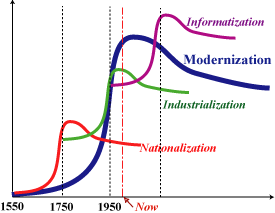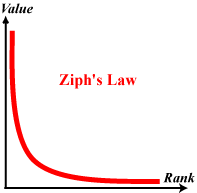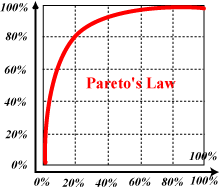Summary |
要約 |
>Top
0. Prologue:
- On Jan. 13, 2005, a reading circle was held by Prof. Shumpei Kumon,
Representative of Glocom, Int'l Univ. regarding to the new book
in 2004 titled 'Introduction to the Study of Information Society'.
- Assuming that the late Prof. Yasusuke Murakami, the first representative
of Glocom deepened the Study of Industrial Society, Prof. Kumon
succeeded his predecessor's lifework, and till now published 'Study
of Civilization of Information' in 1994, and 'Progress of civilization
and informatization' in 2001.
- He aimed to make this book as the first step in describing the
Information Society.
|
0.プロローグ:
- 2005年1月13日に、IECP研究会において公文俊平国際大学GLOCOM代表・多摩大学情報社会学研究所長による新著「情報社会学序説」をテーマとした読書会が行われた。
- 故村上泰亮初代GLOCOM所長のライフワークが「産業社会・学」の構築であったとすれば、公文代表はその後を継いで、本書は1994年の「情報文明論」、2001年の「文明の進化と情報化」の続編としてこの新著を上梓した。
- この本は、情報社会・学の体系化へ向けた第一歩にしたいとの思いであった。
|
>Top 1. Viewpoints of the Study of Information
Society:
- There are two macroscopic viewpoints of the study of Information
Society.
- Diachronic (=Historical) viewpoint:
 The trend of modernization of history starting around from 1550
can be described as a sigmoid curve (blue) , which also can be described
by three phases of smaller sigmoid curves (red, green, and violet).
This seems to compose a fractal structure. The overlapped portion
shows concurrent period of mature stage of the former sigmoid and
advent phase of the next one. The trend of modernization of history starting around from 1550
can be described as a sigmoid curve (blue) , which also can be described
by three phases of smaller sigmoid curves (red, green, and violet).
This seems to compose a fractal structure. The overlapped portion
shows concurrent period of mature stage of the former sigmoid and
advent phase of the next one.
- Synchronic (=of a particular time)
viewpoint:
 Bell-shaped 'normal distribution' (or binomial distribution)
has been long assumed as common and natural distribution, but it
has not been noticed until recent that various social phenomena
show power distribution very often beyond our expectations. Bell-shaped 'normal distribution' (or binomial distribution)
has been long assumed as common and natural distribution, but it
has not been noticed until recent that various social phenomena
show power distribution very often beyond our expectations.
- Composite viewpoint:
- The author assumed that If these two viewpoints are composed together,
there will be interrelation between change of phases shown in sigmoid
curves and power distribution signifying concentration.
- That is:
- an advent phase showing emergence
of a new industry in a sigmoid tends to show lower concentration,
- but a breakthrough phase showing
rapid growth in the sigmoid tends to show more concentration,
probably due to screening by competition.
- Then a mature phase showing stable
or sustaining growth tends to show more oligopolistic situation.
- Thus degree of concentration in power distribution changes
with time.
|
1.情報社会・学の視点:
- まず情報社会・学には、2つのマクロ社会学的視点がある。
- 通時的視点(時間の経過):
- これで見ると近代化は200年毎の三局面 (軍事・国家化、産業化、情報化)を示すS字波 (Sigmoid) の束として分析できる。即ち、
より小さなS字波の連鎖へ分解でき、フラクタル状の構造を示し、また重複部分は前のS字波の成熟期と次のS字波の出現期とが重複することを示している。
- 共時的視点 (同一時点) :
- これで見ると、従来は釣り鐘型の正規分布 (二項分布) が当然視されてきたが、実は少数に集中するようなベキ分布する社会的な現象が多いことが最近注目されている。
- 総合的視点:
- この2つの視点を総合すると、S字波による局面転換と集中度を表すベキ分布との間には相関関係があるというのが新たな著者の仮説である。
- 即ち、
- S字波の形成期で新たな産業が出現する局面では集中度は低いが、
- 突破期では競争による振るい落としの結果、集中度が増大し、
- さらに成熟期では寡占的な状況が見られるのである。
- 即ち、ベキ分布の集中度は、時間とともに変化すると言える。
|
>Top 2. What is power distribution?:
- Vilfredo Pareto, an Italian sociologist & economist has already
discovered in 19C that power-law distribution was seen between an
amount of individual income and number of the individuals of the
income in Europe (later called 'Pareto's law). This relationship
of the both sides in logarithmic scale shows downward-sloping linear.
- George Kingsley Ziph, linguistic professor also discovered the
similar relationship between ranking and scale of English words (appeared in 260,430 words in the novel of 'Ulysses').
- As in the power law, values of arithmetic mean and variance
diverse infinite, distribution of real population is described
between the maximum and minimum value as probability density
function.
- In the power law, extremely majority concentrate near the
minimum value, while precious few have extremely big value.
Consequently such 80%-20% relationship can be observed
as the tread of 20% employees earn 80% of the total income of
the company.
- The normal distribution features in the value of arithmetic
mean and variance (or standard deviation, or root-mean-square),
while population of the power distribution features the value
of maximum (or minimum) and exponent. (See below chart.)
- Ziph's Law and Pareto's Law:
  |
2.ベキ分布とは?:
- ベキ分布は、すでに19世紀末にイタリアの社会・経済学者B.パレートが、欧州での個人所得金額とその所得を得ている人数との間に
の関係 (パレートの法則) が成立していることを示した。これは、両辺の対数をとると右下がりの直線になる。
- また米国の言語学者G.ジップは、英単語の出現順位と出現頻度の間に同様の関係を見いだした。これらはいずれも確率密度関数としてのベキ法則
(Power Law)を示す。
- ベキ法則では平均値も分散も無限大となってしまうので、現実の母集団分布を表現する場合は、ベキ分布式は、ある最大値と最小値の間を確率密度関数として利用する。
- ベキ分布は、極めて多数が最小値近辺に集中する一方で、ごく少数が極めて大きな値をもつ。その結果として80対20の法則のような関係
(例えば2割の社員が8割の利益に貢献するなど) が生まれる。
- なお、正規分布の特性は平均値と分散 (あるいはその平方根である標準偏差) であるのに対し、ベキ分布の母集団の特性は、その最大値
(あるいは最小値)と集中度を表すベキ指数となる。 (左図参照)
|
>Top 3. Power distribution
in Social networks:
- There are such examples which show power distribution:
- Number of people who own scarcity value (jewels, classic cars,
brand name goods, etc.)
- Population of cities in Japan
- Number of attendance of movie films
- Popular travel destination cities during a summer holiday
season.
- Frequency of appearance of English words
- Number of Nobel prize winners in natural science
- Number of medallists in the Athens Olympics in 2004
- Share of makers of optical fiber WDW devices.
- Traffic between cities (logistics by trucks)
- Big airplane disasters
- Frequency of updating of homepages of elementary schools.
- Remarks:
In the case of population of cities in Japan, a bit different
gradients are observed between big cities and medium-small cities,
which may consist of two different power distribution curbs.
- It has not been discovered until the late1990s that phenomena
of social network follow power law. Links which connect with each
pages of Web also comply with this power law. The number of acquaintances
of an individual shows similar distribution: there are such people
called 'connectors' or 'hubs' who have abnormally large human networks
than ordinal people.
|
3. 社会ネットワークでのベキ分布:
- ベキ分布の実例としては、
- 希少価値の高い物の所有数、
- 日本の都市人口、
- 映画の観客動員数、
- 日本の夏の国内旅行先、
- 英単語の出現頻度、
- 自然科学系ノーベル賞受賞者数、
- アテネ・オリンピックでのメダル獲得数、
- 光ファイバーWDM伝送装置のメーカ別シェア、
- 都市間交通 (他県との自動車物流量) 、
- 航空機の大事故、
- 小学校のホームページ更新頻度
などが挙げられる。但し、都市人口の分布などでは、大都市と中小都市ではそれぞれ異なる分布勾配を示すので、2つのベキ分布の合成と解釈することも可能である。
- 社会的ネットワークがベキ法則に従うことが発見されたのは比較的新しく、1990年代後半である。たとえばWebの各ページを結びつけているリンクもベキ法則にしたがっている。これは人々の知人の数などにも同様のばらつきがあり、世の中には他の人々に比べて圧倒的に大きな人脈をもつコネクターやハブと呼ばれる人々が存在する
|
>Top 4. Political intervention
into social unequality:
- From the viewpoint of aiming social reforms it is regarded as
ethically not correct to admit abnormally uneven distribution according
to the power law. In this case it can be justified that political
intervention based on 'public principle.' Thus there are three principles
which can revise or adjust the power law distribution:
- To counter the strong, antitrust and progressive tax system.
- To counter the weak, social welfare, social security, and protection
of tiny companies.
- To raise the level of the middle, cultivation of middle-sized
companies.
- However, power law is typically prevailing in the cyber world
such as transmission traffic volume, number of Web links, frequency
of writing in a mailing list. or blog world, etc. This trend shows
a division into two opposites, which can be a birth of a new class
division.
- Prof. Clay Shirky, P2P expert, points out that it may rather
bring more unequality as the result of increase of diversity and
freedom of choice as well as decrease of restriction of range
and requirement of participants.
- The author interprets two cases in the distribution with or
without interaction among the elements in the system: that is,
1) without interaction the individual elements show power
distribution, as in the case of difference in intelligence, 2) with interaction backseat players' imitation will boost
and make stars. In either case the system has turned out to show
power distribution.
- The power distribution itself could not be popular, but if we
notice particular individual in the distribution, variation could
be possible.
- Particularly in the advent or breakthrough phases, such variation
could be more intense, but in the mature or settled phases it
could be more stable.
- In this universe where we live, power distribution could be
comprehensive. Egalitarians or Liberalists in the modern history
might put a premium on the normal distribution based on their
intelligence bias.
- Imparity in intelligence through informatization may cause
so-called 'digital divide', and such imparity may become bigger
than that of real force or military distribution or that of
wealth distribution, at least in the earlier stage of Information
age.
- Therefore it could be wiser policy to accept the fact of power
distribution and to live symbiotically with it rather than to
correct artificially the imparity.
|
4.社会的不平等への政策的介入:
- ベキ法則による事物の分布が異常な不均等性を占めていることは、社会改革を志向する立場としては倫理的に望ましくないという考えから、「公の原理」にもとづく政策的介入があり得る。即ち、
ベキ法則の分布を修正する3原則として、
- 強者対策としての独占禁止や累進税制、
- 弱者対策としての社会福祉や社会保険、零細企業保護、
- さらに中間の底上げとして中堅企業の育成の政策がある。
- ところが、インターネットというサイバー世界 (トラフィック量、Webに張られたリンク数、メーリングリスト中の書き込み頻度分布、ブロッグの世界など)
においては、ベキ法則が最も典型的に発現しており、そこには新たな階級分裂ともいうべき二極分化の傾向が見られる。
- これは、クレー・シャーキーによれば、多様性と選択の自由が拡大し、選択に参加する人々の範囲や資格制限が少なくなればなるほど、むしろ選択された結果の不平等は大きくなるという指摘である。
- 著者の解釈では、1) 相互作用のない場合の個体分布では、例えば知能格差はそれ自体ベキ分布を示すと思われる。2) 相互作用のある場合のシステム特性としては、縁の下の力持ちによる押し上げやあるいは注目・模倣によるスターの押し上げが起こる。この両方が働いた結果、ベキ分布が起こるのではないかと考えられる。
- ベキ分布自体はあまり人気はないが、ベキ分布の形そのものは変わらないが、その分布の上にいる特定の個体に注目すると変動する可能性はある。
- 特に出現期や突破期では変動が激しく、成熟期や定着期には安定的であるという傾向がある。
- なお、この宇宙の中では、ベキ分布こそが最も普遍的な分布であって、従来の正規分布を重視してきたのは、近代的平等主義者ないしリベラリストの知的バイアスということも考えられる。
- 即ち、情報化にともなう「デジタル・デバイド」的な格差という智の格差は、「共の領域」においてこそ従来の威や富の配分における不均等よりも、少なくとも当面は遙かに大きく急速に拡大すると予想できる。
- ここしばらくはそのベキ分布の不均衡を人為的に是正するよりも、ベキ分布との共生を受け入れやすくする工夫の方が、情報化の出現局面での政策課題とされるべきであろう。
|
>Top 5. Countermeasures
to cope with Power law:
- Human beings in 20th century have suffered serious political failures
by top-down planning and reforms as well as continuing world economy
recession and environmental problems. Thus it became impossible
to regulate local activities of people or those of organizations
by the way of thorough surveillance or control system. Thus the
following viewpoint is getting most important:
- To diffuse and improve artificially local self-organizing systems,
as well as to notice effect of global emergence.
- To encourage development netizens' activism based on the principle
of commons.
- To simulate interaction between models of self-organizing systems,
and if unpreferable results would come out, some appropriate not
ex-ante but ex-post measures should be taken. This mean the
digital divide could not be avoided until certain levels.
- The study of information society will have another aspect as 'Information
Sociology.' Because there are similar historical development of
disciplinary boundaries:
- International politics branched out 'Political Science.'
- Political economics branched out 'Economics.'
- Thus, regarding informatization, Information Sociology may
branch out independent 'Sociology.'
- From the above framework of reference, 'The Study of Information
Society,' or 'Information Sociology' are expected. The author is
ready to start to organize and activate Society of the Information
Sociology before long.
|
5.パワー法則への対応策:
- 20世紀の人類は、トップダウンによる計画や改革など政治の失敗、また世界不況や環境問題に見られるような市場の失敗も共に経験してきた。個人や組織のローカルな行動を徹底的な監視や規制によってコントロールすることは不可能である。今日の重要な視点は
- 人為的なローカルな自己組織システムの普及と改善に努める一方で、グローバルな創発 (Emergence) 効果に注目する。
- 共の原理に立脚した智民アクティビズムの発揮を奨励する。
- 自己組織システム間の相互作業をモデル化したシミュレーションを行い、また実際の好ましくない結果に対しては事前ではなく事後的対処の方策をとる。
デジタル・デバイドはある程度まで不可避と覚悟する。
- 情報社会・学は、「情報・社会学」としての別の意味がある。それは国家化については、
- 国際政治学から政治学が、
- 産業化については、政治経済学から経済学がそれぞれ独立してきた経緯から考えると、
- 情報化については、情報社会学から社会学が独立していくと想定することができる。
- このような視点から「情報社会学」が期待されており、今後、情報社会学会の組織と学会活動を開始する予定である。
|


 The trend of modernization of history starting around from 1550
can be described as a sigmoid curve (blue) , which also can be described
by three phases of smaller sigmoid curves (red, green, and violet).
This seems to compose a fractal structure. The overlapped portion
shows concurrent period of mature stage of the former sigmoid and
advent phase of the next one.
The trend of modernization of history starting around from 1550
can be described as a sigmoid curve (blue) , which also can be described
by three phases of smaller sigmoid curves (red, green, and violet).
This seems to compose a fractal structure. The overlapped portion
shows concurrent period of mature stage of the former sigmoid and
advent phase of the next one. Bell-shaped 'normal distribution' (or binomial distribution)
has been long assumed as common and natural distribution, but it
has not been noticed until recent that various social phenomena
show power distribution very often beyond our expectations.
Bell-shaped 'normal distribution' (or binomial distribution)
has been long assumed as common and natural distribution, but it
has not been noticed until recent that various social phenomena
show power distribution very often beyond our expectations.
